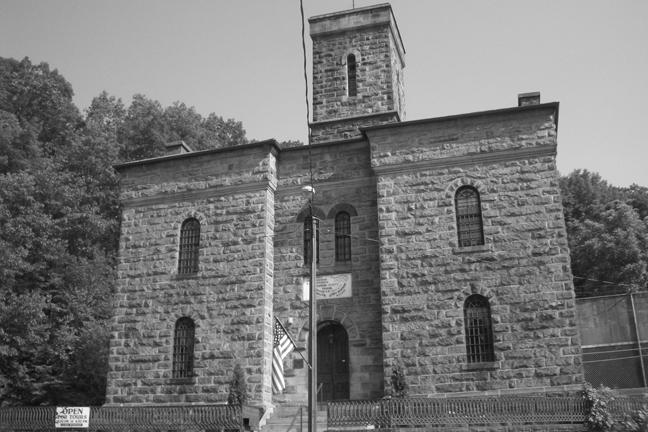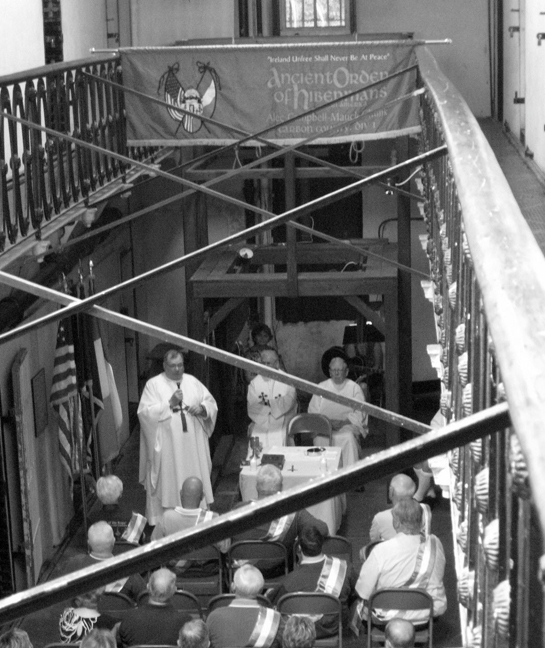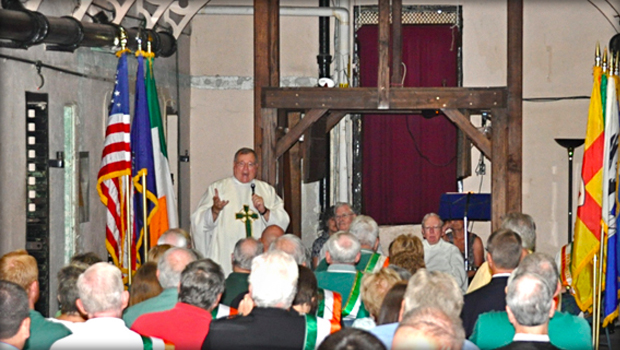Photo Above: Msgr. Francis A. Carbine (right) is with Father Patrick Gallen Schoenauer and Father John McFadden. Photo | Victor Izzo
By Msgr. Francis A. Carbine
I never imagined that I would celebrate Mass inside a cellblock in a prison presided over by a watch tower. Yet, on Saturday, June 16, 2012, I did precisely that. The former county prison was acquired by Tom and Betty Lou McBride in 1995, and renamed “The Old Jail Museum.”
Together with Father Patrick Gallen Schoenauer, Father John McFadden and a tidy congregation, we gathered in Mauch Chunk [today, Jim Thorpe] to remember the ten victims of “Day of the Rope” – June 21, 1877. Four died in Mauch Chunk; six, in the prison in Pottsville.
The reading from the Prophet Isaiah began: “The descendants of my people shall be renowned among the nations.” Father Schoenauer, recalled the 19th century when signs were posted, “Help Wanted. Irish Need Not Apply.”
He asserted that “injustices done to the Irish, must never again happen to anyone!” He stressed themes of compassion and justice. The congregation prayed “for all who are incarcerated – not only in prisons, but incarcerated by addictions.”
Many worshippers wore tri-colored sashes and kilts. A few T-shirts proclaimed “Ireland, One and Indivisible.” Others displayed names of the ten victims who died on the “Day of the Rope.” The Liturgy began with the song, “Be Not Afraid,” and concluded with “Golden Rose, Queen of Ireland.”
Mr. Jerry Sweeney from Bala Cynwyd, recalled “My people came from Donegal, Ireland to Mauch Chunk in 1838 to work on the Lehigh Canal. My ancestral home base is the entire County Donegal.”
Mr. Ed Barry, Ancient Order of Hibernians, Lehigh Valley, said that “I came for the ‘Rope Mass’ because my grandfather, James Boyle, was a Breaker Boy in 1900, and then was advanced to a mule rider along the Lehigh Canal.”

Msgr. Carbine celebrated Mass inside a former prison, now renamed the Old Jail Museum, in Jim Thorpe, PA.
Breaker Boys, often as young as six, sat next to a conveyer belt and separated coal from rocks. Breaker Boys died at early ages from miner’s asthma – called “Black Lung disease.”
Sporting his Donegal tartan kilt, Ed also explained, “if these trials were held today, the cases would be dismissed for lack of evidence.”
Above the altar was a tier of cells. Directly beneath the altar were the dungeons—sixteen cells with no access to light and air. Each cell had two doors. The inner door was made of iron lattice work.
The outer door was made of sheet iron with a five-inch opening for food. Cells did not have toilets. Shackles seem to have been attached to walls. Two “Mollies”—James Kerrigan and Edward Kelly—were confined in this dungeon.
Sarah Newton, a guide, stated that “it is very important to remember the ‘Molly Maguires’ because these men were the founders of labor unions, and other generations can learn from the sufferings of the Irish.”
Sarah described James McParland, Pinkerton detective who worked for the mine owners and who infiltrated Irish meetings, as a “very sneaky, and a terrible man who made up accusations against the ‘Molly Maguires.’”
In fact, some modern researchers hold that the Molly Maguires of Pennsylvania were a phantom organization invented by mine owners as a “terrorist organization.” The historical marker outside the prison is accurate: “Even the existence of the organization remains contested.”
By controlling the local press and the Coal and Iron Police, mine owners could attack as “labor agitators and anarchists” Irishmen trying to form unions. Miners worked a sixty–hour week for $6.00. Safety requirements were minimal and unheeded. No benefits existed in instances of injury or death.
The Miners Museum at Eckely, Pennsylvania, informs visitors that prior to Child Labor Laws, seven and eight–year–old boys worked as Breaker Boys, and many thousands of boys under age fourteen worked—and also died—in the anthracite mines. They were called the “white slaves of the mines.”
The exhibit on the Breaker Boys moves visitors with the text: “The boys in the mine Patches put away their toys early.” A “Patch” was a cluster of a few houses owned by the anthracite companies.
A very large photograph in the museum shows a funeral in a Catholic church in which multiple coffins were placed in the aisles for the Requiem Mass. Deaths had been caused by a cave-in.

The altar was positioned directly in front of the gallows. As a concelebrant, I sat directly beneath the gallows’ opened trap doors When I looked up, there were four nooses. When I shared the Sign of Peace, I did so through the vertical supports of the scaffold.
Photo | Diane Prokop (innkeeper@timesjimthorpe.com)
Many of the mourning women wore shawls.
Mr. Tom McBride, owner of The Old Jail Museum and author of studies on the “Mollies,” noted “I have read 8,000 pages of trial records, and I could find no evidence to convict the men. If I had been on the jury, I would have said “not guilty.”
On June 21, 1877, Michael Doyle, Edward Kelly and John Donohue and Alexander Campbell were hanged in the county prison. Testifying to his innocence, Campbell placed his muddy hand against the wall of cell # 17. The handprint inexplicably remains. The four men kissed the crucifix and then ascended the scaffold.
Immediately after the hangings, Father Michael Bunce anointed the four bodies as he gave the Last Rites of the Church. Since in 1877, the prison had only one door made of three layers of oak reinforced by a sheet of steel, the bodies of the victims were carried out through that door and given to their families.
After concelebrating the Mass on the “Day of the Rope,” and listening to Betty Lou McBride’s reports of ghosts within the fortress prison, I passed through these doors into the sunshine.
Outside, I saw men in high hats and women in long dresses with frills and ruffles. The Mollies, when living, would have seen the same!


Msgr. Carabine – Very interesting post. I am a cousin of yours currently visiting the Cross, and hearing about you and your work on Irish History from Patrick Doherty. I live in Asheville, NC. If you email me, would like to connect offline. I’m also working on family history. – Anne Marie Doherty
I had my nieces on a tour of the jail this past Thurs. Young Sally Newton did a great job relaying all the impoortant facts of the jail and and the history of the Molly Maguires, growing up down the street from the jail, I had a few things to say and Sarah did a great job keeping the whole group involved. I called her Sally because of her Mom’s name is Sally. My nieces live in town and never thought to go see what the tour is about, after growing up there and playing hide,go and seek in the front jail yard.. it takes years to appreciate the history of our own neighborhoods. I would of loved to attended Mass for the Day of the Rope, I won’t miss it next year